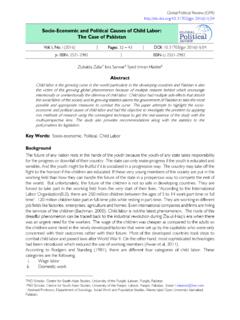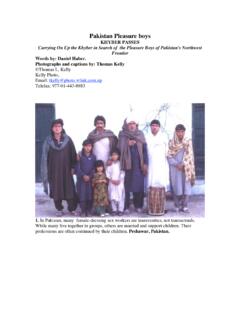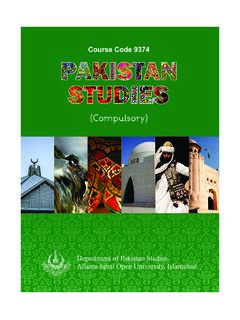Transcription of Pakistan and India Relations: A Political Analysis of ...
1 Global Political Review (GPR). (I-I).01. Pakistan and India relations : A Political Analysis of Conflicts and Regional Security in South Asia Vol. I, No. I (2016) | Pages: 1 - 9 | DOI: (I-I).01. p- ISSN: 2521-2982 | ISSN-L: 2521-2982. Zahid Yaseen* Iqra Jathol Muhammad Muzaffar . Abstract Pakistan and India are two immediate neighbors having common history and culture; in this way, they should have the warmest ties, but their relationships have remained hostile all the time. Kashmir is very important between the two states, over which three main wars have been fought between them. Despite some important and effective peace initiatives, the main problems in maintaining the bitter taste in bilateral relations remain unresolved.
2 Pakistan has always been pleased to suggest mitigating measures, but India 's response is generally not so good. Today, more than 70 years after independence, both Pakistan and India are not concerned for solving long lasting issues like the Kashmir issue, and water issue. Peace process and stability in South Asia lies between the two major countries. So, South Asian regional security structure is affected by the two main players of this region because they cannot find a peaceful solution of lingering issues. Key Words: Pakistan And India , Conflicts, Issues, Regional Security, South Asia. Historical Background of Pakistan India relations After gaining the liberation of Pakistan , Quaid-e-Azam in a meeting convened in the Chamber of Commerce Bombay said that We will live in Pakistan and you will live in India .
3 In this way, we will be the neighbors. We want to live in a friendly way, friends in trade and commerce as two brothers (Hilali, 2005). India and Pakistan were birthed out of bloody partition that heartened each to define herself in hostility towards the other, and they have waged four wars since partition. India has a hegemonic design and never maintains good relations with other small neighboring countries in South Asia (Oimstead, 2014). Pakistan and India have negotiated at various issues between 1984 and 1997, including the disputes over Siachen, sir creek and Tulbul or Wular, with little achievement. The representatives met, debated and prepared contracts, but final approval of management was lacking due to years of mistrust, hate and hostility between the two nations.
4 Neither India nor Pakistan was willing to take the step by changing the positions previously mentioned and finding a compromise or another position. Firearms continued to explode, security forces continued to fight, exhaustion and terrorism continued to kill thousands, and negotiators met on a regular basis, but no positive conversion took place at that time. The Kashmir conflict, the unfinished agenda of partition further plagued their ties with hostility and suspicion. Pakistan has faced three major wars; 1948, 1965 and 1971, and later on, the Kargil conflict and many other serious clashes. Pakistan and India have faced many security risks from the first day of the partition of the sub-continent due to the hostile relationship which was the major challenge for Pakistan in the past.
5 As a matter of fact, traditional Indian capabilities were a major threat to Pakistan , but the atmosphere changed between the two states after a nuclear explosion in 1998. After nuclear tests in May 1998, the head of state and government of India showed typical pragmatism in the fight against long-standing *Lecturer, Department of Political Science, Govt. Post Graduate College Gujranwala, Punjab, Pakistan . M Phil Scholar, International relations , Mnihaj University Lahore, Punjab, Pakistan . PhD Scholar, Department of Politics & IR, International Islamabad University Islamabad, Pakistan . Email: Zahid Yaseen, Iqra Jathol and Muhammad Muzaffar uprisings in Kashmir. India considered this a better force than Pakistan .
6 In the face of this threat, Pakistan conducted its own nuclear test and made a Political decision to ignore all global pressure. Government decisions received general support at the national level, which allowed leaders to cope with national restrictions associated with nuclear explosions. The interplay of nuclear and traditional threats is a new dimension in Pakistan - India relations . Nuclear tests created some equilibrium of power in the region which forced a settlement of the Kargil crisis of 1999 (Johnson, 2005). There is a clear demonstration of nuclear weapons in the subcontinent that has drawn attention to this region of the international community, especially the Kashmir issue. Pakistani and Indian officials say nuclear deterrence has minimized the likelihood of a major war in the region.
7 However, there is a possibility of misunderstanding, and technical errors can lead to accidental nuclear wars. Timely access to real-time nuclear weapons information has become more important. This deficit will have grave concerns and challenges for the population and society of both states. South Asian countries inherited a weak, backward and traditional economic substructure from their colonial masters or the indigenous authoritarian rulers. Except for Sri Lanka and India where some kind of infrastructural development had taken place during the colonial rule, the other countries lacked even the basic economic infrastructure. All the South Asian countries began with the process of modernization and development in the fifties.
8 There have been numerous problems and challenges which have affected the South Asian economies. Despite deep cultural, social, historical and geographical connections, the unusual pattern of positive and passive conflicts between the two South Asian neighbors effectively alienates and separates them (Upreti, ). In the general sphere of suspicion, rivalry and mistrust, new and unexpected problems emerged after 1947 and became extra signs of apparently endless conflict between Pakistan and India . One country's failures, frustrations, and mistakes made one of the most important news in another country, and the gap that widened in 1947 grew even larger. However, other factors bring them closer together or at least prevent them from worsening the conflict.
9 Behind the current rivalry is the recognition of common cultural ties, economic interdependence and, in particular, the desire to avoid a frontal confrontation in the shadow of nuclear weapons. Their relationships are therefore contradictory: the search for solutions to old conflicts goes hand in hand with the emergence of new problems, sometimes separated and sometimes more closely connected. Theoretical Framework The security concept has several implications. Therefore, it must be contextualized. According to Barry Bazan, people do not share the same idea of security because of moral, ideological and regulatory differences. Thus, safety aspects are always determined using a different set of theoretical foundations.
10 Security can only be seen in the real world as a derivative of power or as a synonym for power (Stone 2009). The core of this human-centered approach is normative and can be attributed to social constructivism. The ideal path from a curious and realistic concept of national security to a more comprehensive concept of security, such as human security , to help people engage with local and global levels as a change that shows the power of ideas to model. (Kim 2010). To frame a recognized aspect of reality to facilitate processing to identify specific issues, an interpretation of causality, a moral assessment, and / or recommendations for the article described and the essence of the message to further highlight it.




